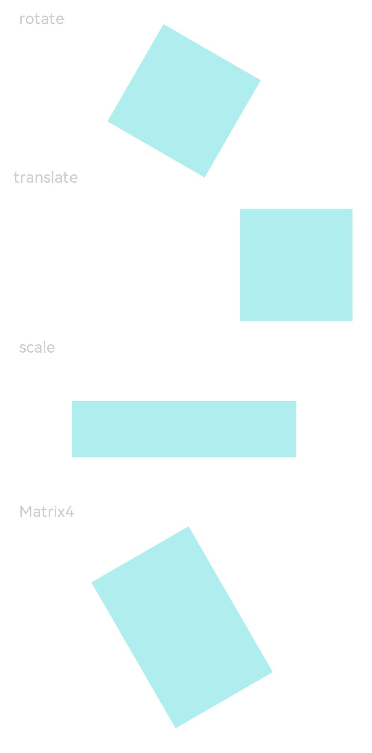# Transformation
Transformation attributes allow you to rotate, translate, scale, or transform a component.
> **NOTE**
>
> The APIs of this module are supported since API version 7. Updates will be marked with a superscript to indicate their earliest API version.
## Attributes
| Name | Type | Description |
| --------- | ---------------------------------------- | ---------------------------------------- |
| rotate | {
x?: number,
y?: number,
z?: number,
angle: number \| string,
centerX?: number \| string,
centerY?: number \| string
} | How the component rotates in the coordinate system (as shown below) with the upper left corner of the component as the coordinate origin. (x, y, z) specifies a vector as the axis of rotation.
- **angle**: rotation angle. A positive angle indicates a clockwise rotation, and a negative angle indicates a counterclockwise rotation. The value can be of the string type, for example, **'90deg'**.
- **centerX** and **centerY** are used to set the center of rotation.
The axis and center of rotation are set based on the coordinate system, which remains where it is when the component is moved.
Default value:
{
x: 0,
y: 0,
z: 0,
centerX: '50%',
centerY: '50%'
}

Since API version 9, this API is supported in ArkTS widgets.|
| translate | {
x?: number \| string,
y?: number \| string,
z? : number \| string
} | How the component is translated in the coordinate system (as shown below) with the upper left corner of the component as the coordinate origin. Values of **x**, **y**, and **z** indicate the translation distance along the respective axis. A positive value indicates a forward movement towards the respective axis, and a negative value indicates a backward movement towards the respective axis. The translation distance can be a number or a string (for example, **'10px'** or **'10%'**).
Default value:
{
x: 0,
y: 0,
z: 0
}

Since API version 9, this API is supported in ArkTS widgets.|
| scale | {
x?: number,
y?: number,
z?: number,
centerX?: number \| string,
centerY?: number \| string
} | Scale ratio along the x-, y-, and z-axis. The default value is **1**. **centerX** and **centerY** are used to set the scale center point.
Default value:
{
x: 1,
y: 1,
z: 1,
centerX:'50%',
centerY:'50%'
}
Since API version 9, this API is supported in ArkTS widgets.|
| transform | [Matrix4Transit](../apis/js-apis-matrix4.md) | Transformation matrix of the component. |
> **NOTE**
>
> If both the **rotate** and **scale** attributes are set for a component, the values of **centerX** and **centerY** conflict. In this case, the one that is set later in time prevails.
## Example
```ts
// xxx.ets
import matrix4 from '@ohos.matrix4'
@Entry
@Component
struct TransformExample {
build() {
Column() {
Text('rotate').width('90%').fontColor(0xCCCCCC).padding(15).fontSize(14)
Row()
.rotate({
x: 0,
y: 0,
z: 1,
centerX: '50%',
centerY: '50%',
angle: 300
}) // The component rotates around the center point of the rotation axis (0,0,1) clockwise by 300 degrees.
.width(100).height(100).backgroundColor(0xAFEEEE)
Text('translate').width('90%').fontColor(0xCCCCCC).padding(10).fontSize(14)
Row()
.translate({ x: 100, y: 10 }) // The component translates by 100 along the x-axis and by 10 along the y-axis.
.width(100).height(100).backgroundColor(0xAFEEEE).margin({ bottom: 10 })
Text('scale').width('90%').fontColor(0xCCCCCC).padding(15).fontSize(14)
Row()
.scale({ x: 2, y: 0.5}) // The height and width are doubled. The z-axis has no effect in 2D mode.
.width(100).height(100).backgroundColor(0xAFEEEE)
Text('Matrix4').width('90%').fontColor(0xCCCCCC).padding(15).fontSize(14)
Row()
.width(100).height(100).backgroundColor(0xAFEEEE)
.transform(matrix4.identity().translate({ x: 50, y: 50 }).scale({ x: 1.5, y: 1 }).rotate({
x: 0,
y: 0,
z: 1,
angle: 60
}))
}.width('100%').margin({ top: 5 })
}
}
```
